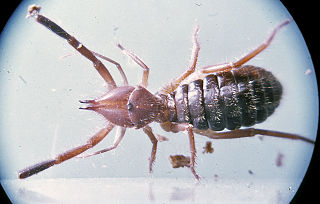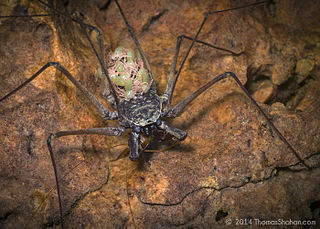
Dementia praecox is a disused psychiatric diagnosis that originally designated a chronic, deteriorating psychotic disorder characterized by rapid cognitive disintegration, usually beginning in the late teens or early adulthood. Over the years, the term dementia praecox was gradually replaced by the term schizophrenia, which initially had a meaning that included what is today considered the autism spectrum.

Emil Wilhelm Georg Magnus Kraepelin was a German psychiatrist. H. J. Eysenck's Encyclopedia of Psychology identifies him as the founder of modern scientific psychiatry, psychopharmacology and psychiatric genetics.

Ammotrechidae is a family of solifuges distributed in the Americas and the Caribbean Islands. It includes 26 described genera and 95 species. Members of this family can be distinguished from members of other families by the absence of claws on tarsi of leg I, tarsal segmentation 1-2-2-(2-4), pedipalps with pairs of lateroventral spines, and by males having an immovable flagellum on the mesal face of each chelicerum. The propeltidium of the Ammotrechidae is recurved.

Hubbardiidae is a family of arachnids, superficially resembling spiders. It is the larger of the two extant families of the order, Schizomida, and is divided into two subfamilies. The family is based on the description published by Orator F. Cook in 1899. The American Arachnological Society assigns the common name hubbardiid shorttailed whipscorpion to members of this family.

Daesiidae is a family of solifugids, which are widespread in Africa and the Middle East. Members of the family are also present in India, Italy, South America, the Balkans, and the single species Gluvia dorsalis in the Iberian Peninsula. A single fossil species is known from Eocene Baltic amber.

Karl Matthias Friedrich Magnus Kraepelin was a German naturalist who specialised in the study of scorpions, centipedes, spiders and solfugids, and was noted for his monograph Scorpiones und Pedipalpi (Berlin) in 1899, which was an exhaustive survey of the taxonomy of the Order Scorpiones. From 1889 to 1914, he served as the Director of the Naturhistorisches Museum Hamburg, which was destroyed during World War II, and worked on myriapods from 1901 to 1916.

Eremobatidae is a family of solifuges, first described by Karl Kraepelin in 1901.
Apozomus is a genus of hubbardiid short-tailed whipscorpions, first described by Mark Harvey in 1992.

Phrynidae is a family of amblypygid arachnida arthropods also known as whip spiders and tailless whip scorpions. Phrynidae species are found in tropical and subtropical regions in North and South America. Some species are subterranean; all are nocturnal. At least some species of Phrynidae hold territories that they defend from other individuals.

Hubbardia is a genus of hubbardiid short-tailed whipscorpions, first described by Orator Cook in 1899.
Schizomus is a genus of hubbardiid short-tailed whipscorpions, first described by Orator Cook in 1899.
Artacarus is a monotypic genus of hubbardiid short-tailed whipscorpions, first described by Orator F. Cook in 1899. Its single species, Artacarusliberiensis is distributed in Ivory Coast and Liberia.
Vinabayesius is a genus of hubbardiid short-tailed whipscorpions, first described by Teruel & Rodriguez-Cabrera in 2021.
Saronomus is a monotypic genus of ammotrechid camel spiders, first described by Karl Kraepelin in 1900. Its single species, Saronomuscapensis can be encountered in Colombia and Venezuela.
Procleobis is a monotypic genus of ammotrechid camel spiders, first described by Karl Kraepelin in 1899. Its single species, Procleobispatagonicus is distributed in Argentina.
Hemiblossia is a genus of daesiid camel spiders, first described by Karl Kraepelin in 1899.
Gluviopsis is a genus of daesiid camel spiders, first described by Karl Kraepelin in 1899.
Karschiidae is a family of solifuges, first described by Karl Kraepelin in 1899.
Paragaleodes is a genus of Galeodid camel spiders, first described by Karl Kraepelin in 1899.
Eusimonia is a genus of karschiid camel spiders, first described by Karl Kraepelin in 1899.








